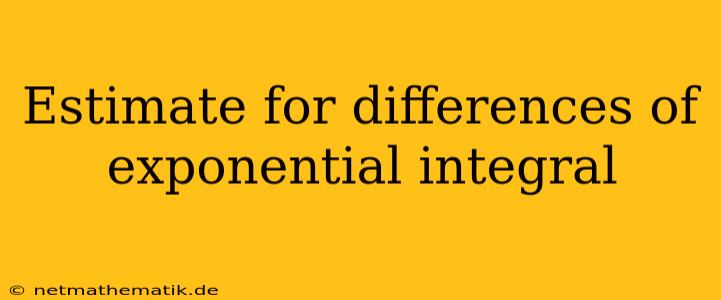Estimating the Differences of Exponential Integrals: A Comprehensive Guide
The exponential integral, denoted as Ei(x), is a special function defined as the integral of the exponential function divided by its argument. It finds applications in various fields like physics, engineering, and mathematics. In many cases, we need to determine the difference between two exponential integrals, Ei(x) - Ei(y). While direct evaluation of the exponential integral can be challenging, there exist various methods for accurately estimating the difference between two values. This article delves into several techniques for estimating the difference of exponential integrals, exploring their effectiveness, limitations, and practical applications.
Asymptotic Expansions for Estimating Differences
One efficient way to estimate the difference of exponential integrals is by utilizing asymptotic expansions. For large values of x and y, the exponential integral can be approximated using the following asymptotic series:
$Ei(x) \approx \frac{e^x}{x} \left( 1 + \frac{1}{x} + \frac{2!}{x^2} + \frac{3!}{x^3} + ... \right)$
To estimate the difference, Ei(x) - Ei(y), we can substitute the asymptotic expansions for both Ei(x) and Ei(y) and subtract the resulting series. This approach is particularly useful when x and y are significantly large, as the series converges rapidly.
Example:
Let's consider an example where we need to estimate the difference Ei(10) - Ei(5). Using the asymptotic expansion, we get:
$Ei(10) - Ei(5) \approx \frac{e^{10}}{10} \left( 1 + \frac{1}{10} + \frac{2!}{10^2} + ... \right) - \frac{e^5}{5} \left( 1 + \frac{1}{5} + \frac{2!}{5^2} + ... \right)$
Truncating the series after a few terms, we obtain a reasonably accurate estimate for the difference.
Limitations of Asymptotic Expansions
While powerful, asymptotic expansions have limitations. They are most accurate for large values of x and y. For smaller values, the convergence of the series might be slower, requiring more terms for accuracy. Additionally, the series may diverge for certain values of x and y. Therefore, it is essential to assess the convergence of the series before applying this method.
Numerical Integration for Precise Estimations
Another approach to estimate the difference of exponential integrals is through numerical integration. This involves approximating the definite integral of the exponential function divided by its argument over the interval from y to x.
Methods for Numerical Integration:
- Trapezoidal Rule: A simple and widely used method that approximates the integral by dividing the interval into sub-intervals and summing the areas of trapezoids formed by adjacent points.
- Simpson's Rule: A more accurate method that uses parabolic segments to approximate the integral, leading to better accuracy compared to the trapezoidal rule.
- Gaussian Quadrature: A sophisticated method that employs weighted sums of function values at specific points within the interval, offering high accuracy even with fewer function evaluations.
Advantages of Numerical Integration:
Numerical integration offers high accuracy, especially when employing advanced methods like Gaussian quadrature. It is applicable to various values of x and y, unlike asymptotic expansions which are more suitable for larger values. Moreover, the accuracy can be controlled by adjusting the number of subdivisions or integration points used.
Limitations of Numerical Integration:
While accurate, numerical integration can be computationally expensive, particularly for complex integrals or when high accuracy is required. The choice of the integration method and the number of subdivisions or integration points can significantly influence the computation time and accuracy of the estimate.
Special Functions and Libraries for Efficient Calculations
Several specialized libraries and mathematical software packages offer pre-built functions for calculating exponential integrals and their differences. These libraries are often highly optimized and efficient, providing accurate results for a wide range of input values. Some popular options include:
- SciPy (Python): A scientific computing library with functions for evaluating special functions, including the exponential integral.
- MATLAB: A numerical computing environment with built-in functions for calculating exponential integrals and their differences.
- GNU Scientific Library (GSL): A free and open-source library providing various numerical and statistical functions, including special functions.
Using these libraries can significantly reduce the computational effort required to estimate the differences of exponential integrals, providing accurate results without implementing complex algorithms.
Applications of Estimating Exponential Integral Differences
The ability to accurately estimate the differences of exponential integrals plays a crucial role in various applications, including:
- Physics: In fields like quantum mechanics and thermal physics, exponential integrals are used to describe phenomena like particle scattering and heat transfer. Estimating their differences is essential for analyzing these processes and extracting meaningful insights.
- Engineering: In areas like fluid dynamics and heat transfer, exponential integrals are employed to model various phenomena. Estimating their differences helps in predicting fluid flow patterns, heat distribution, and other important engineering parameters.
- Mathematics: In various mathematical branches like probability and statistics, exponential integrals arise in solving differential equations and modeling probability distributions. Estimating their differences aids in understanding and analyzing these mathematical concepts.
Conclusion
Estimating the difference of exponential integrals is a fundamental task in various scientific and engineering applications. This article explored different techniques, including asymptotic expansions, numerical integration, and specialized libraries, for achieving accurate estimations. Choosing the appropriate method depends on the specific application, the values of x and y, and the desired level of accuracy. By leveraging these techniques, we can effectively analyze and interpret phenomena involving exponential integrals, contributing to advancements in various fields.
